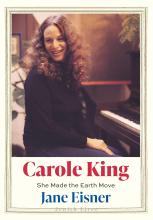Book Reviews

Carole King:
She Made the Earth Move
Jane Eisner
September 16, 2025
ISBN-13: 978-0300259469
Contact: Johanna J. Ramos-Boyer, johanna@jrbpr.biz; johanna@jrbcomm.com
Reviewed by Edith G. Tolchin (edietolchin.com/book-reviews); EGT@edietolchin.com
The task was to “weave a coherent. . . script around a collection of. . . songs written by four opinionated characters, one of whom was deeply reluctant to participate.” That one was Carole King, and the story became the incredibly successful Broadway play, Beautiful: The Carole King Musical.
States Eisner, “The story of Carol Joan Klein King Goffin Larkey Evers Sorenson, of Brooklyn. . .” begins. . . somewhere else. Fortunately, scholar Henry Louis Gates, Jr. of PBS’s Finding Your Roots, worked with King in 2014 to trace her ancestry back to Russia in 1795 and antisemitism.
Her parents, Sidney and Eugenia Klein, met at Brooklyn College.
Carol was born in 1942 in Brooklyn. As a firefighter, her father was exempted from the military. Mom taught her piano and by eight she had appeared on The Horn and Hardart Children’s Hour on TV.
Of note, the reader may find the author’s style backward and anti-feminist when she spoke about Carol’s childhood friend, Barbara, whose single mom took care of the family when “few women worked . . .” (Eisner might have rephrased this as when “few women worked outside the home.”)
Carol’s brother, Richard, who was born severely disabled in 1948, was sent to the infamous Willowbrook State School. (He lived until 2015.) Her father helped build a bungalow colony for city firefighters’ families in Danbury, Conn.
She and her friends at James Madison High formed a singing group, and she “. . . Anglicized her name” to Carole.
Carole graduated early from high school. Her parents divorced, reconciled, and divorced later on. During her short time at Queens College, Carole became pregnant at seventeen, and married Gerry Goffin, twenty, who “. . . started writing songs when (he) was eight . . .”
Carole wrote music, Goffin wrote lyrics, and they “struck gold,” with their first (Shirelles’) hit, “Will You Love Me Tomorrow?” And their babysitter, “Little Eva,” had a hit with their, “The Loco-Motion.” The hits kept coming, as did a “love child” for Gerry Goffin, who was soon diagnosed with mental illness.
Success ensued with countless hits, a move to Laurel Canyon, single parenthood, divorce, marriage to (younger) Charles Larkey, and kinship with James Taylor. The year 1971 was “The Year that Music Changed Everything;” birthing the legendary album, Tapestry, the “highest selling record in (U.S.) history,” holding that place for forty-six years.
Here, Eisner has done exceptional research in the history behind this album, with more than fifty pages devoted to its evolution, including stories behind most songs therein—however, chord progressions for those non-musical might be excessive.
With the success of Tapestry, King moved to a larger home in the Canyon, became pregnant with her third daughter, Molly, played Carnegie Hall and created subsequent, successful albums. Another highlight was playing Central Park in 1973 for about 100,000 people.
Her fourth child, a boy, was born in 1974. Divorced from Larkey in 1976, she moved to Malibu and met Rick Evers, much to producer, Lou Adler’s, dismay. Idaho took over and she married Evers in 1977, who died from an overdose. Within six months she met another Rick (Sorensen). They lived in a rustic, one-room cabin and she learned guitar for lack of piano room. They bought a large ranch in 1981 and married in 1982. It took six years for another album; Eisner attributes the pause to “the isolation of her Idaho lifestyle . . .”
She arranged bar mitzvah lessons for her son while renting in Malibu. Her fourth and final divorce ended in 1989, she joined Democratic campaigns, and City Streets rock album was released. “This was the first time I really felt comfortable rocking.”
Beautiful premiered in 2014, without King’s assistance, but by 2019 she claimed “. . . the final number for herself . . .”
Eisner ends well with “As a musician, a mother, an activist, an icon, (King) made the earth move . . . traversing the globe and landing where she now calls home.”
CONCLUSION:
This book is part of a series on (famous) “Jewish Lives,” so the emphasis throughout is on Carole’s Jewish background—though frequent references to that background may seem forced and extraneous to qualify her story for this Yale University Press book series.
Expect to discover much about music and the business behind it.
However, if you have (musical) stars in your eyes like millions, Carole King: She Made the Earth Move, by Jane Eisner, is everything you’ll ever want to learn about this celebrated artist.
